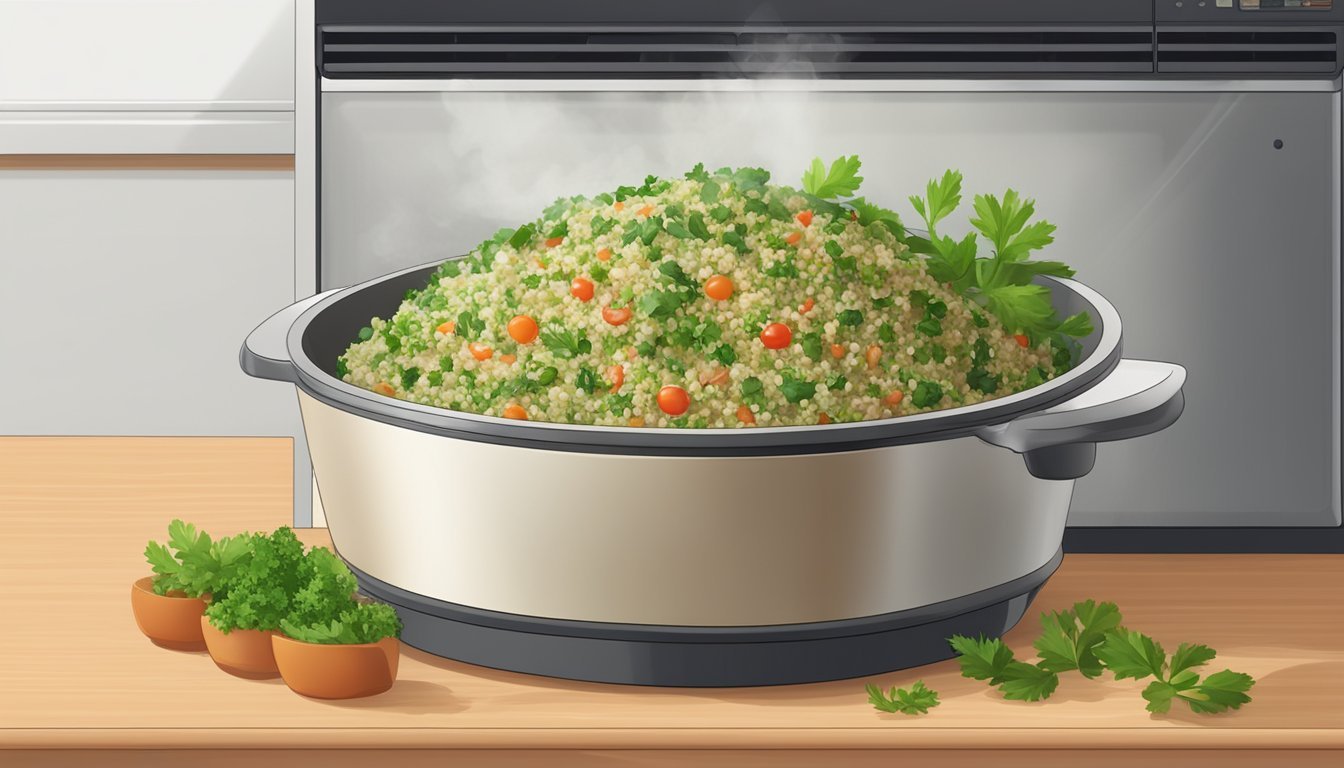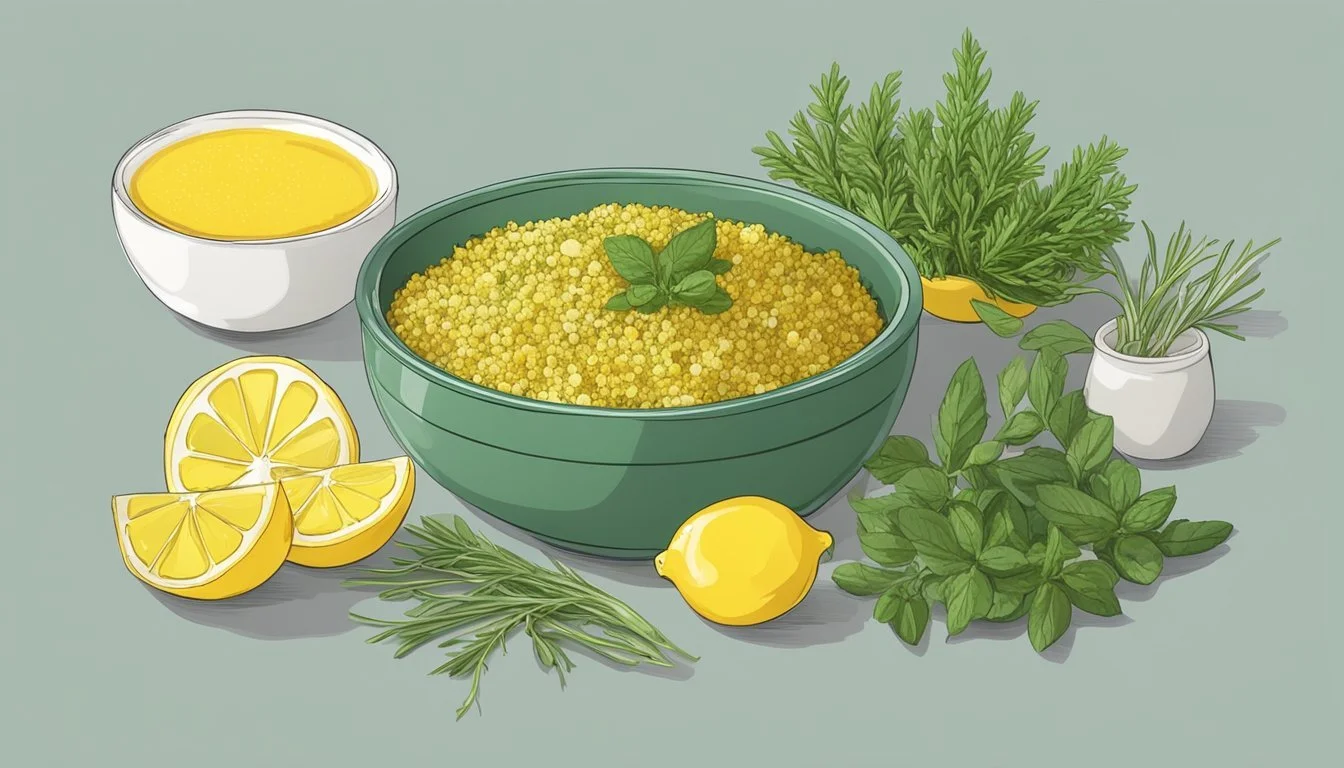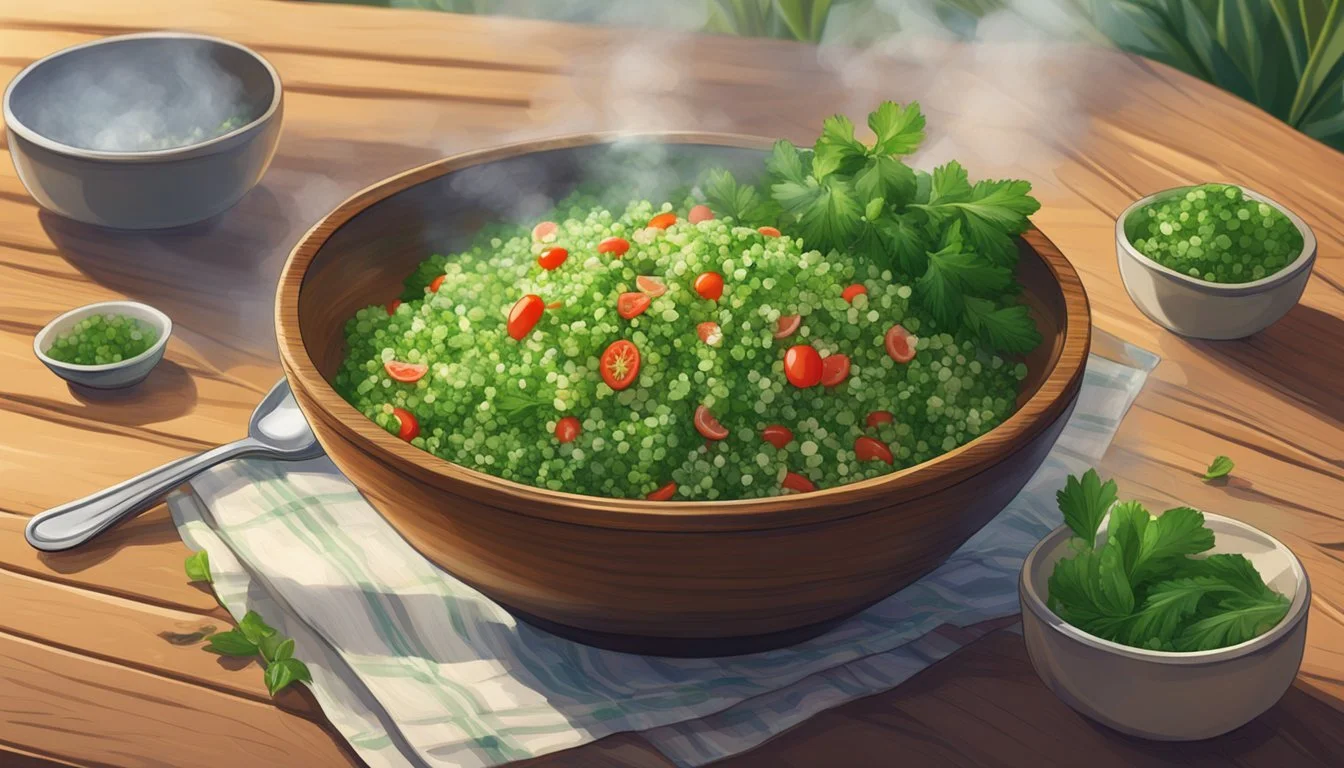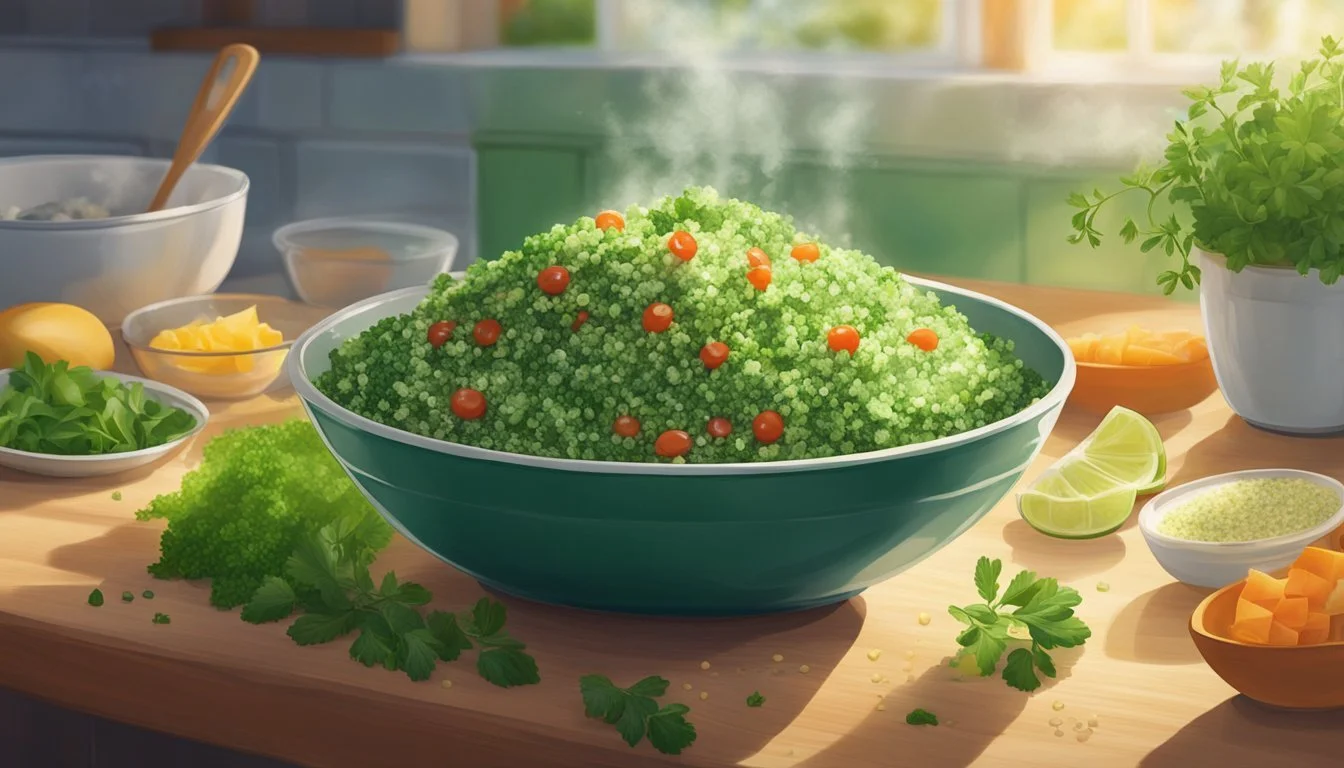Best Way to Reheat Tabbouleh
Ensuring Fresh Herbs and Tender Bulgur
Tabbouleh is a vibrant Middle Eastern salad known for its fresh flavors and health benefits. It is traditionally made with finely chopped parsley, mint, and other herbs, mixed with bulgur wheat, fresh vegetables like tomatoes and cucumber, and dressed with lemon juice and olive oil. The texture of tabbouleh is largely dependent on the freshness of the herbs and the tenderness of the bulgur. When it comes to reheating tabbouleh, the challenge is to maintain these key qualities.
Often served cold or at room temperature, tabbouleh doesn't typically require reheating. However, if one finds themselves with a portion that has been refrigerated and wishes to take the chill off, doing so while preserving the salad’s integrity requires delicate handling. They must factor in the sensitive nature of the fresh ingredients to avoid wilting or sogginess.
The methods chosen to reheat tabbouleh should aim to gently warm the dish without compromising its texture and flavor. This involves avoiding high heat and prolonged exposure to heat sources that could affect the bulgur and herbs. The goal is to achieve a balance where the bulgur is tender, and the herbs remain vibrant and full of flavor, just as they were when the tabbouleh was first prepared.
The Basics of Tabbouleh
Tabbouleh is a vibrant and refreshing salad with a unique balance of flavors, textures, and nutrients. Central to its composition are bulgur wheat, fresh herbs like parsley and mint, along with a mixture of tomatoes, olive oil, and lemon juice.
Understanding Tabbouleh Components
Each ingredient in tabbouleh serves a purpose and contributes to the overall harmony of the dish. The combination of bulgur, fresh greens, and dressing results in a satisfying texture and a burst of flavors that epitomizes the essence of this Middle Eastern classic.
The Role of Bulgur in Tabbouleh
Bulgur is the foundation of tabbouleh, providing a tender chewiness that absorbs the dressing and compliments the crispness of the vegetables. It is a form of whole wheat that has been cleaned, parboiled, dried, and cracked, resulting in a quick-cooking grain perfect for this salad.
Parsley: The Signature Herb of Tabbouleh
Parsley isn't just a garnish in tabbouleh; it's the star. It provides a fresh, grassy flavor and a green vibrancy. For the best results, one should finely chop the leaves to release their essential oils and to ensure the herb is evenly distributed throughout the dish.
Incorporating Fresh Mint
Mint adds a cool and refreshing note to tabbouleh. Finely chopping the mint leaves and adding them to the salad enhances the complexity and freshness of the flavors. The quantity of mint should complement rather than overpower the parsley.
Tomatoes – Adding Freshness and Texture
Tomatoes, rich in juice and flavor, are crucial for adding a bright contrast to the denser components of tabbouleh. They introduce an aspect of texture as well as a tangy sweetness that enlivens the palate. It's essential to use ripe but firm tomatoes to ensure the salad remains fresh.
Optimal Use of Olive Oil and Lemon Juice
A proper emulsion of olive oil and lemon juice dresses tabbouleh, coating the bulgur and herbs, and marrying the flavors together. The oil adds smoothness and depth, while the lemon juice provides a zesty, slightly acidic brightness crucial for the overall balance.
Preparing Tabbouleh
The success of a tabbouleh dish lies in the quality of the ingredients and how they're sliced and seasoned. It's essential to choose the right components, balance the flavors meticulously, and chop vegetables and herbs with precision.
Choosing the Right Ingredients
When preparing tabbouleh, one must select high-quality ingredients. For the bulgur, favor a tender variety as it constitutes the base of the dish. Fresh herbs, particularly parsley, should be bright green and aromatic to ensure the tabbouleh has a fresh taste. When sourcing extra virgin olive oil, look for ones with a fruity note to complement the herbaceous profile of the dish.
Essential Ingredients:
Bulgur (tender variety)
Fresh parsley (bright green, ideally flat-leaf)
Extra virgin olive oil (fruity profile)
Balancing Flavors: Salt, Pepper, and Additional Seasoning
Accurate seasoning is crucial for a flavorful tabbouleh. Start with a measured amount of salt to enhance the natural flavors of the ingredients. Pepper should be used judiciously to add just a hint of heat without overshadowing the herbs. Depending on personal taste, one can add additional seasoning, but it's vital to maintain the delicate balance to not overpower the fresh character of the tabbouleh.
Seasoning Balance:
Salt: Start with a small amount, adjust as needed
Pepper: Use sparingly
Additional Seasoning: Optional and should be used with restraint
Techniques for Chopping Vegetables and Herbs
The technique for chopping vegetables and herbs significantly affects the texture and distribution of flavor in tabbouleh. Vegetables should be diced uniformly for even flavor with each bite. Herbs, especially chopped parsley, need a sharp knife to avoid bruising and to retain their vibrant color and freshness. It's important that one chops these by hand to achieve the right size without turning them into a mash.
Chopping Techniques:
Use a sharp knife for precise cuts
Dice vegetables uniformly
Chop parsley and other herbs by hand, avoiding over-processing
By carefully selecting ingredients, seasoning well, and chopping precisely, one can prepare a tabbouleh dish with fresh herbs and tender bulgur that is both traditional and delightful.
Reheating Tabbouleh
When reheating tabbouleh, one must focus on preserving the texture of the bulgur and maintaining the freshness of the herbs. The right balance of moisture is key to restoring the dish to its desired taste and consistency.
Preserving Freshness and Texture While Reheating
To ensure the bulgur remains tender and the herbs fresh, one should reheat tabbouleh gently. Microwave reheating is not recommended, as it can wilt the delicate herbs and make the bulgur mushy. Instead, one may opt to briefly steam the bulgur if separation is necessary, being careful not to overcook it. Fresh herbs should not be reheated; instead, they can be refreshed by gently tossing them into the tabbouleh once it has reached a pleasant temperature.
Maintaining the Delicate Balance of Moisture
The moisture level in tabbouleh is pivotal, as it influences both the dish's flavor and texture. To manage moisture:
Fluff the bulgur with a fork before attempting to reheat, to separate the grains and evaluate moisture content.
If the tabbouleh appears dry, one can sparingly add a few drops of water or olive oil to reintroduce moisture. Mix this in carefully to avoid sogginess.
Conversely, if the tabbouleh seems too wet, allowing it to rest at room temperature to allow some moisture to evaporate can be beneficial.
The bulgur should not be saturated, and the fresh herbs should have a vibrant look and aroma. By managing the reheat process and moisture, the integrity of tabbouleh's flavor and texture can be preserved.
Serving Tabbouleh
When serving tabbouleh, it is essential to consider the accompaniments that highlight its fresh flavors and the portion sizes that make it a satisfying yet light fare.
Accompaniments and Pairings
Tabbouleh pairs beautifully with a variety of Mediterranean dishes and can be served in multiple contexts, from a casual lunch to a festive dinner. It traditionally complements hummus and pita bread, allowing diners to enjoy a mix of textures and flavors. The creamy richness of baba ganoush, with its smoky undertones, provides a delightful contrast to the sharp, herbaceous notes of tabbouleh. Additionally, tzatziki, a tangy cucumber yogurt sauce, can be served alongside to add a refreshing touch that balances the dish. One can consider the following pairings to elevate the tabbouleh experience:
Hummus: A creamy spread that seamlessly integrates the flavors of chickpeas, tahini, and lemon.
Pita bread: Soft or toasted, it offers a pleasant chew and a convenient way to scoop servings of tabbouleh.
Tzatziki: It introduces a cucumber-yogurt freshness that cleanses the palate.
Baba Ganoush: This eggplant dip imparts a smoky essence, enhancing the tabbouleh's taste profile.
Recommended Portion Sizes
For portion sizes, tabbouleh is often enjoyed as a light and healthy option. A single serving size is typically around 1/2 to 3/4 cup when it's being served as part of a larger meal with other dishes. When tabbouleh is the main attraction, a serving size of 1 to 1 1/2 cups is sufficient to be filling while still preserving the dish’s role as a refreshing salad. Here is a simple guideline for serving sizes:
Context Serving Size Part of a meal 1/2 to 3/4 cup Main attraction 1 to 1 1/2 cups
The key is to ensure that when served, tabbouleh retains its character as a light, nourishing dish that whets the appetite and delights the senses, perfectly portioned to complement the dining occasion.
Storage and Leftover Management
Proper storage of tabbouleh is essential for maintaining the freshness of herbs and the tenderness of bulgur wheat. The following guidance outlines the best practices for storing freshly made tabbouleh and managing leftovers effectively.
Storing Fresh Tabbouleh
Fresh tabbouleh should be stored in the refrigerator to preserve its flavors and prevent spoilage. Here are specific steps one should follow:
Prepare for Storage: Ensure the tabbouleh is at room temperature before storing to prevent condensation, which could make the herbs soggy.
Select the Right Container: Utilize an airtight container to keep the tabbouleh fresh.
Maximize Freshness: If fresh herbs are abundant, wrap them in a dry paper towel and store them in a zip-top bag before adding them to the tabbouleh to prolong their vibrancy.
Proper Techniques to Store Leftover Tabbouleh
To keep leftover tabbouleh tasting as good as the day it was made, one should consider the following:
Prompt Storage: Place any leftovers in the refrigerator within two hours of serving to prevent bacterial growth.
Airtight Containers: Store in airtight containers to maintain quality and prevent the absorption of other odors.
Refrigerator Shelf Life:
Leftover Tabbouleh: 4-5 days
Freezing Versus Refrigeration
When deciding whether to freeze or refrigerate leftover tabbouleh, keep in mind the following information:
Refrigeration: Ideal for short-term storage, keeping the tabbouleh ready to eat for a few days.
Freezing: Not recommended for tabbouleh, particularly if it contains a large amount of fresh herbs as freezing can cause them to lose their texture and flavor. However, the bulgur component can be frozen separately if desired.
Refrigeration Freezing Texture Preservation Good for herbs Not recommended for fresh herbs Convenience Ready to eat Requires thawing Shelf Life 4-5 days Not advised for complete dish
It is advised to consume leftover tabbouleh while it is as fresh as possible to enjoy its full flavor and texture.
Nutritional Profile of Tabbouleh
Tabbouleh is a Middle Eastern salad known for its fresh herbs and whole-grain bulgur, combining a rich array of vitamins and fiber while remaining suitable for both vegan and vegetarian diets.
Understanding the Health Benefits
Tabbouleh is packed with fiber, which is essential for digestive health. The bulgur wheat is a whole grain that provides a source of complex carbohydrates and fiber, promoting satiety and digestive regularity. Additionally, the abundance of fresh herbs, like parsley, contributes significant vitamins, such as vitamin C and vitamin A, which are crucial for immune function and vision, respectively.
Tabbouleh in Different Diets
Given that tabbouleh is made from plant-based ingredients, it is inherently vegan and vegetarian. It is often included in healthy eating plans because of its high nutrient-density. The ingredients are natural, making tabbouleh a favorable dish for those seeking a healthy eating option with robust flavors that don't rely on animal products.
Caloric and Nutritional Information
A typical serving of tabbouleh contains the following nutritional information:
Nutrient Amount per serving Calories ~150 kcal Total Fat ~7 g Saturated Fat ~1 g Cholesterol 0 mg Sodium ~300 mg Total Carbohydrates ~20 g Dietary Fiber ~5 g Sugars ~2 g Protein ~3 g Vitamin A Varies Vitamin C Varies
Note: Values can vary depending on the recipe and portion size.
This light and nutritious dish is often lauded for being high in fiber with a balance of carbohydrates and proteins, along with being a good source of vitamins and minerals. The specific combination of ingredients in tabbouleh can vary, which may affect the nutritional content.
Variations of Traditional Tabbouleh
Traditional tabbouleh is a versatile dish, often open to interpretation and adaptation. Whether accommodating dietary restrictions or experimenting with local flavors, several variations have emerged, staying true to the essence of this Middle Eastern classic.
Using Quinoa or Couscous for Gluten-Free Alternatives
Quinoa, (What wine goes well with quinoa?) a protein-rich seed, serves as an excellent gluten-free alternative to bulgur wheat in tabbouleh recipes. Its tender texture and slight nutty flavor can enhance the traditional profile of tabbouleh, making it suitable for those with gluten sensitivities. Similarly, couscous (What wine goes well with couscous?), though not gluten-free, is another popular substitute, offering a different texture and quicker preparation time compared to the standard bulgur.
Quinoa: Rinse thoroughly, cook until tender, generally a 1:2 ratio of quinoa to water.
Couscous: Steam or soak according to package instructions for a light and fluffy result.
Incorporating Different Types of Fresh Herbs
Beyond the classic flat-leaf parsley, other fresh herbs can add complexity and a unique twist to tabbouleh. Curly parsley, with a slightly more bitter taste, or dill, with its aromatic and sweet notes, can be used. Scallions or green onion might replace traditional onions to give a milder, yet still pronounced, flavor.
Flat-leaf parsley: Chopped finely for a mild, clean taste.
Curly parsley: Chopped finely for a more robust flavor.
Dill: Chopped finely and added sparingly to complement, not overpower.
Cultural Variations and Regional Differences
Tabbouleh has regional interpretations across the Middle Eastern and Mediterranean traject. In Lebanon and Syria, tabbouleh is herb-focused, with bulgur playing a minor role. Conversely, a Turkish tabbouleh might feature a greater bulgur-to-herb ratio. Lebanese restaurants often serve it as part of a mezze spread, especially popular in the summer. Regional variances might also include ingredients like pomegranate molasses or different types of peppers for a unique flavor profile.
Lebanon/Syria: Herb-forward with minimal bulgur.
Turkey: More bulgur-centric, often with a touch of Turkish spice.
Mediterranean: May include regional ingredients like pomegranate for added sweetness or tang.
Advanced Tabbouleh-Making Tips
In the pursuit of perfecting tabbouleh, attention to the bulgur's texture and the use of appropriate kitchen equipment is paramount. By refining these elements, one can ensure that each bite of tabbouleh is flavorful and well-balanced.
Soaking and Preparing Bulgur for Optimal Texture
To achieve the ideal tenderness in bulgur wheat, a whole grain that's the foundation of tabbouleh, the type of bulgur used is significant. Fine bulgur is preferable as it soaks up flavors well and has a quicker preparation time due to its smaller size.
Soaking: Fine bulgur does not require cooking; it only needs to be hydrated. Cover the bulgur with boiling water and let it sit, covered, until it has absorbed the liquid and is parboiled—usually taking about 20 to 30 minutes.
Texture: For a lighter texture, fluff the bulgur with a fork after soaking to separate the grains before mixing it with other ingredients. This prevents clumping and ensures that each grain remains distinct.
Choosing and Using the Right Kitchen Equipment
The proper equipment can greatly enhance the efficiency and outcome of preparing tabbouleh.
Food Processor: When it comes to the herbs, a food processor can be a valuable asset. It should be used to attain a fine chop of parsley and mint, which is essential for even distribution throughout the salad.
Mixing: A large mixing bowl provides ample space to combine the tabbouleh ingredients thoroughly, and a spatula or wooden spoon is ideal for gentle folding, which maintains herb freshness.
Oil: Incorporate extra-virgin olive oil using a drizzle technique for an even coating. This not only contributes to the mouthfeel but also helps to preserve the herbs and keeps the bulgur tender.
Tabbouleh FAQs
When reheating tabbouleh to preserve the freshness of its herbs and the tenderness of its bulgur, understanding the nuances of its ingredients and preparation methods is crucial.
Addressing Common Concerns
Can tabbouleh be reheated without losing its flavor and texture?
Absolutely. The key is in the approach. Tabbouleh's bulgur should remain tender, and herbs fresh. Reheating it at a low temperature will avoid wilting or browning the herbs.
What type of tomatoes should I use to ensure a lasting freshness in my tabbouleh?
One should opt for firm, ripe cherry or roma tomatoes. Heirloom tomatoes add variety but also hold up well.
How can I prevent my tabbouleh from getting soggy?
To prevent sogginess, one should ensure that ingredients like tomatoes are diced and well-drained, reducing excess moisture which could soften the bulgur too much.
What's the best way to store tabbouleh?
It should be kept in the refrigerator in an airtight container. If prepared with fresh ingredients, tabbouleh can be a perfect make-ahead dish.
Tips for Perfect Tabbouleh Every Time
Selecting Ingredients:
Tomatoes: Choose ripe cherry tomatoes for a burst of flavor or firm roma tomatoes for a heartier texture.
Onions: Red onions have a milder taste that won't overpower the dish, but spring onions provide a crisp texture.
Herbs: Fresh herbs are non-negotiable for their vibrancy and should be incorporated just before serving if possible.
Preparation Tips:
Spices: A pinch of cinnamon or allspice can enhance the flavors without being overpowering.
Bulgur: It should be soaked or cooked until just tender, then drained thoroughly to avoid mushiness.
Serving Suggestions:
While tabbouleh stands out on its own, it pairs exceedingly well with pita bread or as a fresh complement to Greek salad or Greek orzo salad.
Incorporating these practices can result in a perfect tabbouleh that maintains its intended contrasting textures and fresh flavors upon reheating.








